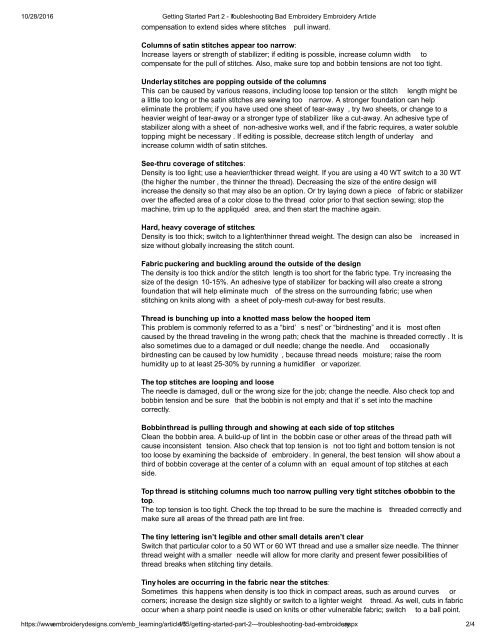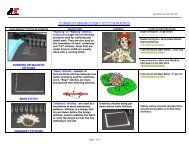Compiled Embroidery Skill Articles
Create successful ePaper yourself
Turn your PDF publications into a flip-book with our unique Google optimized e-Paper software.
10/28/2016 Getting Started Part 2 Troubleshooting Bad <strong>Embroidery</strong> <strong>Embroidery</strong> Article<br />
compensation to extend sides where stitches<br />
pull inward.<br />
Columns of satin stitches appear too narrow:<br />
Increase layers or strength of stabilizer; if editing is possible, increase column width to<br />
compensate for the pull of stitches. Also, make sure top and bobbin tensions are not too tight.<br />
Underlay stitches are popping outside of the columns:<br />
This can be caused by various reasons, including loose top tension or the stitch length might be<br />
a little too long or the satin stitches are sewing too narrow. A stronger foundation can help<br />
eliminate the problem; if you have used one sheet of tearaway , try two sheets, or change to a<br />
heavier weight of tearaway or a stronger type of stabilizer like a cutaway. An adhesive type of<br />
stabilizer along with a sheet of nonadhesive works well, and if the fabric requires, a water soluble<br />
topping might be necessary . If editing is possible, decrease stitch length of underlay and<br />
increase column width of satin stitches.<br />
Seethru coverage of stitches:<br />
Density is too light; use a heavier/thicker thread weight. If you are using a 40 WT switch to a 30 WT<br />
(the higher the number , the thinner the thread). Decreasing the size of the entire design will<br />
increase the density so that may also be an option. Or try laying down a piece of fabric or stabilizer<br />
over the affected area of a color close to the thread color prior to that section sewing; stop the<br />
machine, trim up to the appliquéd area, and then start the machine again.<br />
Hard, heavy coverage of stitches:<br />
Density is too thick; switch to a lighter/thinner thread weight. The design can also be<br />
size without globally increasing the stitch count.<br />
increased in<br />
Fabric puckering and buckling around the outside of the design:<br />
The density is too thick and/or the stitch length is too short for the fabric type. Try increasing the<br />
size of the design 1015%. An adhesive type of stabilizer for backing will also create a strong<br />
foundation that will help eliminate much of the stress on the surrounding fabric; use when<br />
stitching on knits along with a sheet of polymesh cutaway for best results.<br />
Thread is bunching up into a knotted mass below the hooped item:<br />
This problem is commonly referred to as a “bird’ s nest” or “birdnesting” and it is most often<br />
caused by the thread traveling in the wrong path; check that the machine is threaded correctly . It is<br />
also sometimes due to a damaged or dull needle; change the needle. And occasionally<br />
birdnesting can be caused by low humidity , because thread needs moisture; raise the room<br />
humidity up to at least 2530% by running a humidifier or vaporizer.<br />
The top stitches are looping and loose:<br />
The needle is damaged, dull or the wrong size for the job; change the needle. Also check top and<br />
bobbin tension and be sure that the bobbin is not empty and that it’ s set into the machine<br />
correctly.<br />
Bobbin thread is pulling through and showing at each side of top stitches:<br />
Clean the bobbin area. A buildup of lint in the bobbin case or other areas of the thread path will<br />
cause inconsistent tension. Also check that top tension is not too tight and bottom tension is not<br />
too loose by examining the backside of embroidery. In general, the best tension will show about a<br />
third of bobbin coverage at the center of a column with an equal amount of top stitches at each<br />
side.<br />
Top thread is stitching columns much too narrow, pulling very tight stitches of bobbin to the<br />
top.<br />
The top tension is too tight. Check the top thread to be sure the machine is threaded correctly and<br />
make sure all areas of the thread path are lint free.<br />
The tiny lettering isn’t legible and other small details aren’t clear:<br />
Switch that particular color to a 50 WT or 60 WT thread and use a smaller size needle. The thinner<br />
thread weight with a smaller needle will allow for more clarity and present fewer possibilities of<br />
thread breaks when stitching tiny details.<br />
Tiny holes are occurring in the fabric near the stitches:<br />
Sometimes this happens when density is too thick in compact areas, such as around curves or<br />
corners; increase the design size slightly or switch to a lighter weight thread. As well, cuts in fabric<br />
occur when a sharp point needle is used on knits or other vulnerable fabric; switch to a ball point.<br />
https://www.embroiderydesigns.com/emb_learning/article/1 165/gettingstartedpart2troubleshootingbadembroidery .aspx 2/4




